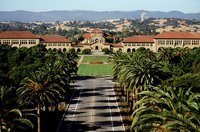Center of Excellence
 It took some time to get back to Sweden from San Fransisco. The flight from there to London is ten hours.
It took some time to get back to Sweden from San Fransisco. The flight from there to London is ten hours.Back there I had the opportunity of spending some hours at Stanford University.
It is one of the true centers of excellence in our present world.
It has an impressive track record in many respects. In recent years it has achieved a certain fame as the birthplace of what is much of todays Silicon Valley and the role it has played in the US and global economy.
Faculty and alumni of Stanford have helped to create companies like Cisco, eBay, Google, Hewlett-Packard, Silicon Graphics, Sun and Yahoo!. Most of them are headquartered in Silicon Valley.
And in all probability there are now small start-up companies on or nearby the campus which we will hear a lot about in a couple of years. The innovative spirit is very clearly there.
But I spent my few hours there primarily listening to Professor Irving Weissman telling about the state of stem cell research and the possibilities of regenerative medicine.
It's a controversial subject. Professor Weissman and his colleauges at the Stanford Center for Stem Cell Biology are at the very forefront of the international efforts in this area. But ethnic and religious concern have led to serious restrictions on what they can and what they can't do.
The potential, as professor Weismann described it, is obviously enormous, even if it will take time for the results to start to be applied widely around the world. But there are obviously the possibility of dealing with some of the most difficult diseases threathening us today.
Asked why he did not move to another country with his research in order to avoid the US restrictions, he answered that he was already in another country, namely California. State policy there is clearly in favour of stem cell research. But otherwise he mentioned other scientists moving to Britain, Singapore or China in order to continue their research.
Of the top 20 universities in the world 17 are in the United States, and Stanford is clearly one of them.
Even the shortest visit gives a strong impression of how we in Europe have often underfunded and underused our universities. We see them purely as edicational institutions, which they of course are, but not as the hubs of innovation, research and change in society.
Stanford University is a 2,9 billion dollar enterprise.That's a lot of money.
But there is little doubt that the benefits of what's being achieved there is many times that sum.
We ought to learn from that.


<< Home